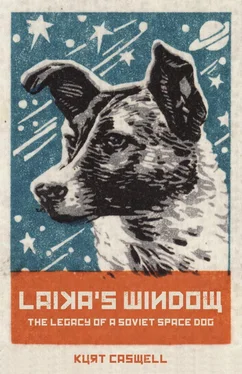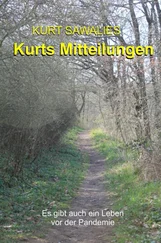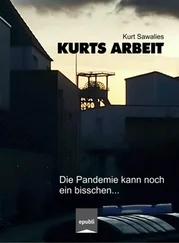With all these considerations, Laika really belongs to the world. She was a Russian dog with a Russian heart, a stray from the streets of Moscow, a creature of the Soviet experiment, but once lofted into space she was not fixed or bound to any one place, to any one people. She belonged to no one and to everyone, the first living creature from Earth to go where no nation, no corporation, and no individual has any claim. In looking at Laika’s story and at the scientists and engineers who worked with her, perhaps we can better understand human empathy—its source, its importance, and the dangers of its reduction and loss—in order to posit that empathy is essential to caring for our world, to maintaining it as a place where we may all live healthy, productive lives as part of what the writer Wendell Berry has called “the feast of creation.”
¤
When the Soviet team went to select a space dog to launch in Sputnik II , Laika earned high marks. In her training she managed the extreme conditions of the centrifuge and the vibration table, and she kept a calm and even disposition during prolonged periods of isolation in the training capsule (up to twenty days). She did not become aggressive or fight with her kennel mates, as so many smaller dogs are prone to do. The women and men who worked with her describe her as sweet-natured, patient, and determined, a dog that wanted to please, a dog talented in adapting to the place and the people with whom she found herself. She was a survivor, a quality that saw her through that hard life on the streets and, then, the rigorous training in the space dog program. Indeed, Korolev and Yazdovsky both knew that street dogs made the best space dogs, because they were tough, scrappy, and they could endure extremes of temperature, hunger, and isolation.
And yet Laika was not the most qualified dog for Sputnik II . The team felt strongly that a dog called Albina was the best choice. Albina was a favorite among the scientists and engineers, “a celebrity who had twice been in research rockets at the height of hundreds of kilometers,” writes engineer Oleg Ivanovsky (under the pen name Aleksei Ivanov) in The First Steps: An Engineer’s Notes . Albina had flown both times with a dog called Kozyavka, or Little Gnat, in June 1956. Having already proven herself in flight, she was the perfect choice for Sputnik II , but had she not risked enough? Didn’t she deserve something for the contribution she had already made? Retirement, perhaps, a soft bed in a warm house? Albina had something else going for her too: she had just given birth to a litter of puppies, three little pups, one of which looked a lot like Laika. Yazdovsky thought it too cruel to take the mother from her pups and subject her again to the risks of rocket flight.
Ordinary rocket flight was risk enough, but Sputnik II was not going to be an ordinary flight. Khrushchev had ordered the launch for no later than November 7, 1957, in time to celebrate the Bolshevik Revolution, which was about a month after Sputnik I . The Soviets knew how to send a dog to the edge of space on a rocket and bring it back safely with a system of parachutes (they had achieved this many times), but they did not know how to return a dog from orbit. It had never been done before. The know-how and hardware just didn’t exist. That kind of research and development took time, and the Soviet team was in a mad race against the clock, and against the United States, to again achieve the impossible. So unlike previous and later rocket trials using dogs, the dog chosen to fly on Sputnik II was not just taking a risk, it was never coming back. The dog chosen for Sputnik II was going to die in space or perhaps on the ride into space. Whatever, it was going to die.
So which dog to choose: Laika or Albina?
For the team, it was a tough choice, but a choice had to be made. Ivanovsky records this moment in The First Steps: “The great majority inclined to send Laika into space. Everyone knew that the animal would die, and there was no way to bring her back to Earth, because we did not know how to do that. So it was particularly painful to send Albina, everyone’s darling, to her death. Thus, Laika became the first.” By the first, Ivanovsky means “the primary,” as all the space dogs scheduled to fly were assigned a second, or a backup, in case something happened to prevent the primary from flying. Albina, then, was named Laika’s second. Ivanovsky’s words also mean that Laika would be first into orbit, first for the glory of the Soviet Union, and first for all time. And she would also be the first, and the only, dog in the Soviet space dog program to be sent to her death.
¤
Laika’s capsule on Sputnik II contained a small, round window. While the satellite, along with Laika and her capsule, were destroyed on reentry, the window is plainly visible in photographs and drawings, and in a replica at the Memorial Museum of Cosmonautics in Moscow. The window, Asif Siddiqi told me, measured about 6.3 inches in diameter and was made of transparent thermoplastic, called Perspex. Questions surrounding the window’s purpose stand as a lodestar for this book, out of which a central metaphor has arisen. Wearing a flight suit to secure the sensors implanted in her body, Laika was positioned inside a small chamber within the capsule so that, while she was able to stand, to sit, to lie down, and to move about a little, she was unable to turn around. The design meant that she faced the window looking out. Was this the sole reason for the window, so that Laika could look out at the Earth as she left it? Or did scientists believe that the view or, more so, the entry of natural light would help calm her as she endured the thrust of the rocket and then the strange sensation of weightlessness? Or was the window installed to serve the scientists only, to monitor Laika before she was loaded onto the rocket? What were these scientists’ intentions? After launch, of course, the sole user of the window was Laika, a window through which she looked at what? Did Laika take in the first view of Earth from space and look beyond it into the cosmos? Could she in fact see out? And if she could, what did she see from up there? What did she see down here? Or was the view from Laika’s window occluded by darkness, blocked by the payload fairing protecting the satellite as it rose into orbit? More specifically, did the Soviet team remove the payload fairing after Sputnik II achieved orbit?
Remember the famed 1972 photograph of the first full view of the Earth taken from the American spacecraft Apollo 17 on its way to the moon? That single image, known as the Blue Marble, is one of the most reproduced photographs in human history. Why? Because it, more than any other image, brings human beings face-to-face—and for the first time—with the vulnerability and special quality of our planet home. Because that photograph allows us to see, to witness, even to feel that the Earth is fragile, and its fragility makes it beautiful. Because that image brings us all to square with what we have always known: that we have but one home, one Earth, and we must take care of it, if we are to survive. “[The Earth] truly is an oasis,” said Apollo 15 commander Dave Scott in an interview for the documentary In the Shadow of the Moon , “and we don’t take very good care of it. I think the elevation of that awareness is a real contribution to saving the Earth.” It’s a jewel, he said, the “jewel of the Earth hanging in the blackness of space.”
On April 12, 1961, some four years after Laika’s mission, the Soviet Union put the first human being into orbit, cosmonaut Yuri Gagarin. During his single orbit of the Earth, Gagarin gazed back on our planet home. He could not see the Earth entire as the Apollo astronauts would as they sailed away from it, but he was the first human being to look down from up so high. “Orbiting Earth in the spaceship, I saw how beautiful our planet is,” Gagarin later wrote. “People, let us preserve and increase this beauty, not destroy it.” Gagarin’s is a necessary plea, and further evidence that seeing the Earth from space changes the fundamental way we think of ourselves, making it difficult to see ourselves as superior to other living beings, as the inheritors of a planet filled with resources and placed here for us, as made in the image of a benevolent god. Seeing the Earth from space, we must face a terrifying reality: that we are fragile, vulnerable, and possibly alone. What shall we do with this new point of view? How shall we account for who and what we are, and for the fragility and essentiality of our planet?
Читать дальше












